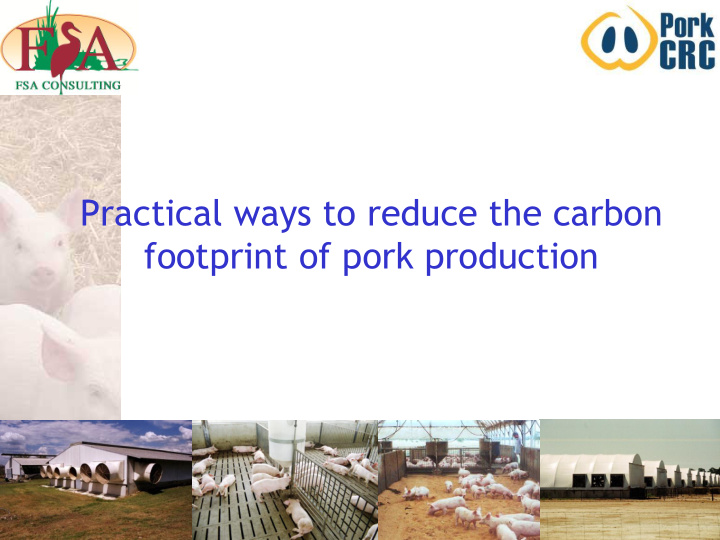



Practical ways to reduce the carbon footprint of pork production 1
What is a ‘carbon footprint’? • Full supply chain analysis of greenhouse gas emissions associated with pork production – taking into account direct emissions (from manure), and ‘embedded’ emissions from purchased inputs such as feed and fuel: Diesel Use transport refining oil transport extraction • Focus is on ‘emissions intensity’ – i.e. the kilograms of GHG in carbon dioxide equivalents (CO 2 -e) per kilogram of pork • Main GHG sources at the farm are: – Methane (CH 4 ) from effluent ponds – Nitrous oxide (N 2 O) from land application of manure – On-farm energy use 2
GHG Mitigation Options 3
Case study: Victoria • Conventional, multi-site farrow-finish • Currently in the process of installing covered ponds and flares at all sites, combined heat and power (CHP) in future 4
Carbon footprint with standard ration and no covered ponds 5
GHG mitigation scenarios • Scenario 1: CAP-CHP with standard production • Scenario 2: CAP-CHP with optimised effluent storage and utilisation • Scenario 3: CAP-CHP with optimised diet (low GHG feed ingredients) • Scenario 4: CAP-CHP with optimised diet, optimised effluent storage and utilisation, soil carbon sequestration and tree planting (all options) 6
Scenario results 7
Summary – Practical ways to reduce your carbon footprint 1. Covering effluent ponds is the most effective mitigation there is for conventional piggeries. Cost- benefit generally good for piggeries >1000 sows F-F 2. Pond covering should be followed up with electricity generation to offset input costs and emissions. 3. Lower dietary CP when possible without compromising performance, use local protein grains (may be more expensive) 4. Improving herd efficiency over time will lower GHG 5. Utilise by-product feeds, reduce transport distances 8
Summary – Practical ways to reduce your carbon footprint 1. Direct irrigation of untreated effluent is an option for smaller piggeries to avoid using anaerobic ponds 2. Minimising effluent storage for at least part of the year should also reduce emissions 3. In Deep litter systems, maintaining dry litter should reduce emissions 4. Reducing storage time for litter / sludge / manure before effective utilisation will reduce emissions 5. Improving effluent / sludge / litter utilisation to: i) reduce fertiliser use, ii) maximise carbon sequestration 9
Contact details: Stephen.wiedemann@fsaconsulting.net 10
Recommend
More recommend